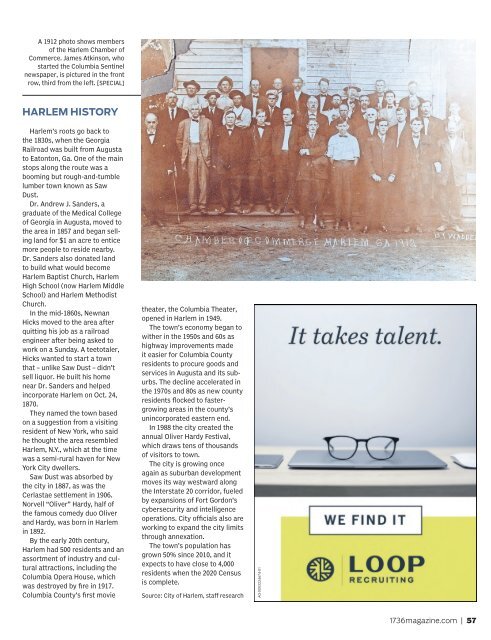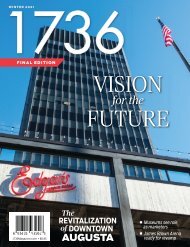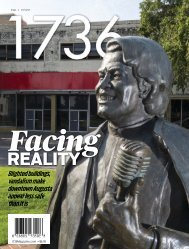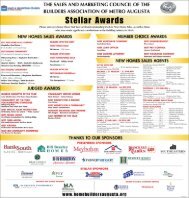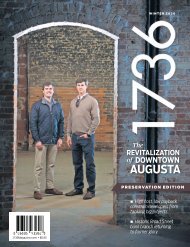Education Edition - 1736 Magazine, Fall 2019
- No tags were found...
You also want an ePaper? Increase the reach of your titles
YUMPU automatically turns print PDFs into web optimized ePapers that Google loves.
A 1912 photo shows members<br />
of the Harlem Chamber of<br />
Commerce. James Atkinson, who<br />
started the Columbia Sentinel<br />
newspaper, is pictured in the front<br />
row, third from the left. [SPECIAL]<br />
HARLEM HISTORY<br />
Harlem’s roots go back to<br />
the 1830s, when the Georgia<br />
Railroad was built from Augusta<br />
to Eatonton, Ga. One of the main<br />
stops along the route was a<br />
booming but rough-and-tumble<br />
lumber town known as Saw<br />
Dust.<br />
Dr. Andrew J. Sanders, a<br />
graduate of the Medical College<br />
of Georgia in Augusta, moved to<br />
the area in 1857 and began selling<br />
land for $1 an acre to entice<br />
more people to reside nearby.<br />
Dr. Sanders also donated land<br />
to build what would become<br />
Harlem Baptist Church, Harlem<br />
High School (now Harlem Middle<br />
School) and Harlem Methodist<br />
Church.<br />
In the mid-1860s, Newnan<br />
Hicks moved to the area after<br />
quitting his job as a railroad<br />
engineer after being asked to<br />
work on a Sunday. A teetotaler,<br />
Hicks wanted to start a town<br />
that – unlike Saw Dust – didn’t<br />
sell liquor. He built his home<br />
near Dr. Sanders and helped<br />
incorporate Harlem on Oct. 24,<br />
1870.<br />
They named the town based<br />
on a suggestion from a visiting<br />
resident of New York, who said<br />
he thought the area resembled<br />
Harlem, N.Y., which at the time<br />
was a semi-rural haven for New<br />
York City dwellers.<br />
Saw Dust was absorbed by<br />
the city in 1887, as was the<br />
Cerlastae settlement in 1906.<br />
Norvell “Oliver” Hardy, half of<br />
the famous comedy duo Oliver<br />
and Hardy, was born in Harlem<br />
in 1892.<br />
By the early 20th century,<br />
Harlem had 500 residents and an<br />
assortment of industry and cultural<br />
attractions, including the<br />
Columbia Opera House, which<br />
was destroyed by fire in 1917.<br />
Columbia County’s first movie<br />
theater, the Columbia Theater,<br />
opened in Harlem in 1949.<br />
The town’s economy began to<br />
wither in the 1950s and 60s as<br />
highway improvements made<br />
it easier for Columbia County<br />
residents to procure goods and<br />
services in Augusta and its suburbs.<br />
The decline accelerated in<br />
the 1970s and 80s as new county<br />
residents flocked to fastergrowing<br />
areas in the county’s<br />
unincorporated eastern end.<br />
In 1988 the city created the<br />
annual Oliver Hardy Festival,<br />
which draws tens of thousands<br />
of visitors to town.<br />
The city is growing once<br />
again as suburban development<br />
moves its way westward along<br />
the Interstate 20 corridor, fueled<br />
by expansions of Fort Gordon’s<br />
cybersecurity and intelligence<br />
operations. City officials also are<br />
working to expand the city limits<br />
through annexation.<br />
The town’s population has<br />
grown 50% since 2010, and it<br />
expects to have close to 4,000<br />
residents when the 2020 Census<br />
is complete.<br />
Source: City of Harlem, staff research<br />
<strong>1736</strong>magazine.com | 57<br />
1117_T_54_AM____.indd 57<br />
10/25/<strong>2019</strong> 12:34:59 PM


